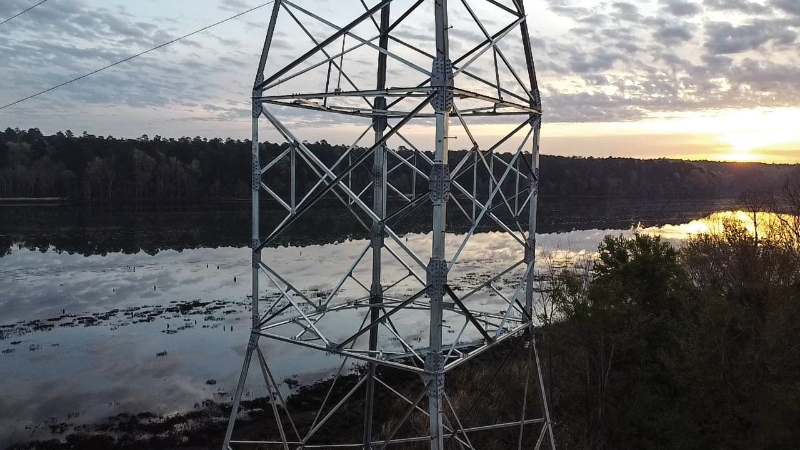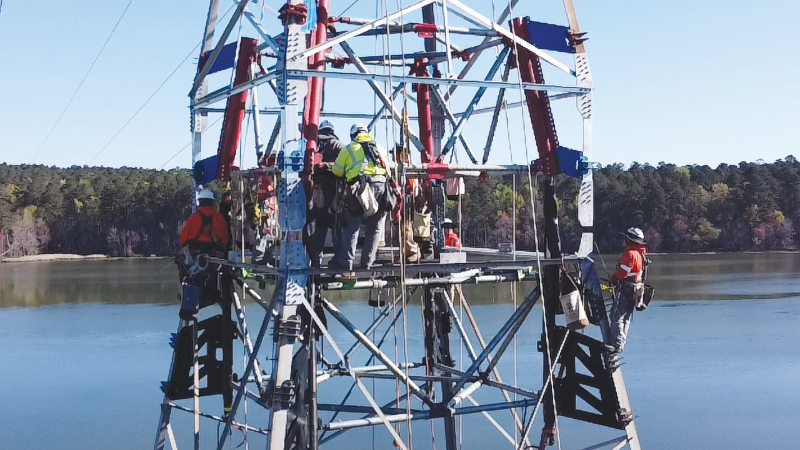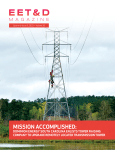Earlier this year, Ampjack America completed a tower raise project for Dominion Energy South Carolina. The 115/46kV Stevens Creek-McCormick transmission line upgrade project was located in the middle of an island that was inaccessible by road or boats large enough to shuttle heavy equipment. For this quarter's Grid Transformation Forum column, we spoke with Kelvin Rogers, general manager of Transmission Operations and Construction for Dominion Energy South Carolina, and Mike Haight, business development director for Ampjack about the challenges the project posed, and how both companies teamed up to tackle those challenges.
EET&D: Describe the situation that prompted Dominion Energy to seek assistance from the specialized tower raising company?
Dominion: While conducting a routine inspection, Dominion Energy identified some necessary maintenance and enhancements to our overhead lines across the Savannah River.
The project included replacing existing wires with larger lines to accommodate increased demand for energy across the growing region. These larger lines would also need to be raised an additional 15 feet to ensure safe clearance across the river.
EET&D: Mike, would you talk about the challenges your team faced?
MH: As Kelvin explained, there was an existing tower on an island in the middle of the Savannah River. Raising a tower on this remote island became a critical inflection point for the project team. Because it was a difficult location to get to, we were initially concerned that the project would not be feasible due to the cost or timelines to access the island. Also, working on an island in the middle of a major river was problematic, as the water levels fluctuated day-to-day, as expected. To complicate matters, there is no established access to the island, and it would have been extremely difficult and costly to build a bridge to access the tower for traditional construction equipment to change out the tower.
EET&D: How did you address those challenges?
MH: We were able to overcome each challenge with a series of solutions that would allow us to raise the tower and keep the project on track for Dominion. First, we used our “crane-in-a-box” lift system that allowed us to raise the structure 15 feet to the required final height. This system is small and packaged in a manner that allows us to Heli lift the equipment into the project site, without the need for roads or other conventional access methods. We are used to working in very remote locations, but they are normally in dry and mountainous regions, so the next challenge was to create a dry and level work platform to combat the fluctuation of water levels. We were able to use scaffolding at the base of the tower to create a dry and safe work platform for the crew, and a place to land the equipment being flown to the project site. We were then able to utilize a small boat to shuttle the line personnel to the site to complete the work each day. Once the equipment and personnel were onsite, it was a normal tower raise for our team, and they executed it perfectly.
EET&D: What were the final results of your effort?
MH: As the project was delivered as an Engineer-Procure-Construct model, we completed detailed engineering and operational planning prior to moving into procurement and construction. The engineering phase included pre-construction tower and foundation audits which identified minor maintenance requirements, which were completed during the construction phase. By the end of the project, there was a 15-foot mid-body extension to the existing tower that would allow for the new transmission line to be brought through and maintain adequate ground and waterway clearance. There was no need to develop or spend capital on temporary access to the tower site.
EET&D: As the utility that sought the tower raising company’s expertise, how did you feel about the way the situation was addressed?
Dominion: Because of the tower’s remote location on an island in the Savannah River, replacing the pole presented several challenges. This included getting a new pole and other construction equipment out to the island.
The tower raising company offered a unique solution by raising the existing tower rather than replacing it. To do this, they added new structural steel sections and designed them to accommodate the new, larger wires. They also provided the necessary engineering, material, transportation and construction.
EET&D: How would you suggest other utilities address a similar challenge?
MH: Rather than always defaulting to changing-out structures, utilities now can look at alternative methods, like raising towers using innovative construction methods such as a hydraulically driven tower lift system. The ability to access places with compact equipment and perform tower raises can open opportunities and make what seems like an impossible challenge a much easier project scope. Technology exists in the market and the “we’ve always done it that way” approach is not necessarily bringing the best value to the utility and stakeholders.
Dominion: [The tower raising company] was able to engineer a safe, innovative solution for this project without replacing the tower. Their work helps us continue to deliver safe, reliable and resilient energy to our customers.
 Mike Haight, director of Business Development for Ampjack America has spent the past 15 years in various different sales and business development roles in the power utility industry. He has spent much of his time in working with utilities to educate and help their engineering teams to integrate new and innovative technologies. Additionally, Haight has worked with many tool and equipment manufactures to train electric line workers on safety and work methods with their hot line tools.
Mike Haight, director of Business Development for Ampjack America has spent the past 15 years in various different sales and business development roles in the power utility industry. He has spent much of his time in working with utilities to educate and help their engineering teams to integrate new and innovative technologies. Additionally, Haight has worked with many tool and equipment manufactures to train electric line workers on safety and work methods with their hot line tools.
 Kelvin Rogers is the general manager for Electric Transmission Operations and Construction for Dominion Energy South Carolina. He oversees the engineering, construction, operation and maintenance of DESC’s transmission, substation and protective relay systems, which serve more than 800,000 customers in South Carolina. Rogers has worked for Dominion Energy since 1988. He earned his bachelor’s degree in electrical engineering from Clemson University.
Kelvin Rogers is the general manager for Electric Transmission Operations and Construction for Dominion Energy South Carolina. He oversees the engineering, construction, operation and maintenance of DESC’s transmission, substation and protective relay systems, which serve more than 800,000 customers in South Carolina. Rogers has worked for Dominion Energy since 1988. He earned his bachelor’s degree in electrical engineering from Clemson University.











